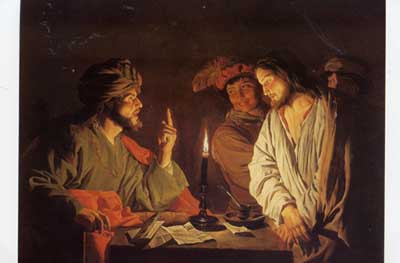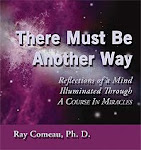 The great bird's wings consist of 72 white steel fins, ranging in size from 26-105 feet, spreading to 217 feet at its widest point, wider than a Boeing 747 jet. The wings "flap" to close and open each day at noon. In a museum guidebook, these wings are described as "a visual symbol of transformation."
The great bird's wings consist of 72 white steel fins, ranging in size from 26-105 feet, spreading to 217 feet at its widest point, wider than a Boeing 747 jet. The wings "flap" to close and open each day at noon. In a museum guidebook, these wings are described as "a visual symbol of transformation."When my wife, Christine, and I visited the museum on Valentine's Day, we first saw the "flapping" wings and figured that would be the highlight of the day's visit. However, moving through the exhibitions of paintings and sculptures from Ancient Asian and African Art to Contemporary Art, walking on white marble floors quarried from Italy, and looking through corridors bound by curved windows overlooking the lake, we came across the true highlight of the day, the light illuminating the painting by the 17th Century Dutch painter, Matthias Stom (1600-1652) entitled, "Christ Before the High Priest."
 This is the commentary on the painting from the guidebook:
This is the commentary on the painting from the guidebook:This painting depicts the moment when the high priest Caiaphas accuses Christ of blasphemy because of his refusal to deny that he was the Son of God. Stom has captured beautifully the psychological drama of this decisive moment in Christ's Passion by contrasting an emphatic, gesticulating Caiaphas with a strangely serene and saddened Christ, whose countenance betrays his knowledge of future events. His quiet beauty contrasts with the gleeful snickers of the two false witnesses who lurk behind him. Intense candlelight casts an eerie, pale hue over the figures and further heightens the psychological tension of the confrontation. The three- quarter-length figures and their placement close to the picture plane transform the painting into a powerful and moving image that was meant to engage the viewer and inspire religious devotion.
Here is the passage from Matthew depicted in the painting:
And the high priest arose, and said unto him, Answerest thou
nothing? what is it which these witness against thee?
But Jesus held his peace, And the high priest answered and said
unto him, I adjure thee by the living God, that thou tell us whether
thou be the Christ, the Son of God.
Jesus saith unto him, Thou hast said; nevertheless I say unto
you, Hereafter shall ye see the Son of man sitting on the right hand
of power, and coming in the clouds of heaven.
Then the high priest rent his clothes, saying, He hath spoken
blasphemy; what further need have we of witnesses? behold, now ye
have heard his blasphemy.
Matthew 26: 62-65
Because Jesus did not deny that he is the Son of God, the high priest considers that he committed blasphemy, "the act of insulting, or showing contempt, or lack of reverence for God." In the painting, the high priest is looking directly at Jesus; but he is unable to see the Christ. He is incapable of seeing the reality of the Son of God because he is seeing only his own reflection as a Son of man. Although the high priest's face is shown in light, he is not experiencing light because he is seeing only the darkness of his own projection. What you see outside is simply a reflection of what is seen inside, first. This brings us to Jesus' Course in Miracles, a modern-day masterpiece in which he teaches us to undo the projections of our minds so that we can learn to see with vision.
Projection makes perception. The world you see is what you gave it, nothing more than that. But though it is no more than that, it is not less. Therefore, to you it is important. It is the witness to your state of mind, the outside picture of an inward condition. T-21.Intro.1:1-5
The real witnesses are not those mockingly, derisively, holding Jesus, the real witness is the projection of Jesus as a blasphemer. This image witnesses to the high priest's state of mind. He is thinking with a part of his mind that has no source in reality.
As a man thinketh, so does he perceive. Therefore, seek not to change the world, but choose to change your mind about the world. Perception is a result and not a cause. And that is why order of difficulty in miracles is meaningless. Everything looked upon with vision is healed and holy. Nothing perceived without means anything. And where there is no meaning, there is chaos. T-21.Intro.1:6-12
Stom has captured beautifully the psychological drama of this decisive moment in Christ's Passion by contrasting an emphatic, gesticulating Caiaphas with a strangely serene and saddened Christ, whose countenance betrays his knowledge of future events. (Guidebook)
Caiaphas is gesticulating emphatically because he is damning himself first, and then quickly projecting it onto the world that seems to be outside.
Damnation is your judgment on yourself, and this you will project upon the world. See it as damned, and all you see is what you did to hurt the Son of God.
T-21.Intro.2:1,2
You, too, Caiaphas are the Holy Son of God.
If you behold disaster and catastrophe, you tried to crucify him. If you see holiness and hope, you joined the Will of God to set him free. There is no choice that lies between these two decisions. And you will see the witness to the choice you made, and learn from this to recognize which one you chose. The world you see but shows you how much joy you have allowed yourself to see in you, and to accept as yours. And, if this is its meaning, then the power to give it joy must lie within you. T-21.Intro.2:3-8
In the painting, Jesus is not looking a Caiaphas; he is gazing at the candle, completely at peace. He is in a state of mind of peace, the Christ mind, and what he sees in the world is the reflection of that state of mind. The light of the candle suffusing the painting is analogous to the light of the world.
In His Course in Miracles, Jesus teaches that you, too, Dear Reader, are the Christ. When you do the lessons and learn to forgive your projected thoughts, you can experience, My holiness envelops everything I see.
From my holiness does the perception of the real world come. Having forgiven, I no longer see myself as guilty. I can accept the innocence that is the truth about me. Seen through understanding eyes, the holiness of the world is all I see, for I can picture only the thoughts I hold about myself. W-p1.58.1
Caiaphas is also the Son of God, but he is limiting himself to be the Son of man, attacking the Son of God. Jesus, of course, sees with vision, and he is defenseless against the charges.
But Jesus held his peace.
His quiet beauty contrasts with the gleeful snickers of the two false witnesses who lurk behind him. Intense candlelight casts an eerie, pale hue over the figures and further heightens the psychological tension of the confrontation. (Guidebook)
And the high priest arose, and said unto him, Answerest thou nothing?
If Stom were to paint the next moment, he would have Jesus look up, make eye contact with the high priest and answer knowingly: Thou hast said.
He would be telling Caiaphas that what you see in me is a projection of an image that starts in your mind. That image will not change until your mind changes by asking for help to forgive thoughts that have no source in reality. It does not matter in your condition, now, what I say. You will hear what you want to hear. Therefore, the only answer could possibly be a reminder that you are projecting: Thou hast said.
Jesus demonstrates to Caiaphas that his defensive attack is preventing him from experiencing that there is a plan.
What could you not accept, if you but knew
that everything that happens, all events,
past, present and to come, are gently planned
by One Whose only purpose is your good?
Perhaps you have misunderstood His plan,
for He would never offer pain to you.
But your defenses did not let you see
His loving blessing shine in every step
you ever took. While you made plans for death,
He led you gently to eternal life.
Your present trust in Him is the defense
that promises a future undisturbed,
without a trace of sorrow, and with joy
that constantly increases, as this life
becomes a holy instant, set in time,
but heeding only immortality.
Let no defenses but your present trust
direct the future, and this life becomes
a meaningful encounter with the truth
that only your defenses would conceal.
Without defenses, you become a light
which Heaven gratefully acknowledges
to be its own. And it will lead you on
in ways appointed for your happiness
according to the ancient plan, begun
when time was born. Your followers will join
their light with yours, and it will be increased
until the world is lighted up with joy.
And gladly will our brothers lay aside
their cumbersome defenses, which availed
them nothing and could only terrify.
W-p1.135:18-20
The three-quarter-length figures and their placement close to the picture plane transform the painting into a powerful and moving image that was meant to engage the viewer and inspire religious devotion. (Guidebook)
I am not convinced that Stom wanted to "inspire religious devotion." I think, rather, he wanted to inspire the recognition that we are, indeed, the Christ. After all, he did name his painting, "Christ Before the High Priest," not "Jesus before the High Priest."
To look at this drama in the context of Mel Gibson's movie, please read my article entitled, "It is Accomplished!" The Passion of the Christ. Click on the link below.
http://www.throughamirrorbrightly.com/A-it_is_accomplished.htm
